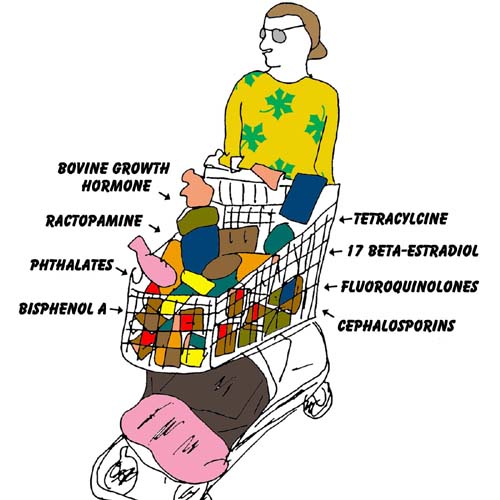
Worse than Germs--the Chemicals Used to Disinfect Meat
Martha Rosenberg
The meat and seafood you buy probably looks and smells fine. But processors may be using unsavory drugs to retard bacterial growth and the drugs do not appear on the label.
::::::::
The meat and seafood you buy probably looks and smells fine. But processors may be using unsavory drugs to retard bacterial growth and the drugs do not appear on the label.
Many human antibiotics are used in meat production like penicillin, neomycin and sulfa and Cipro-like drugs. The FDA and medical community are trying to clamp down on the massive use of such drugs on large scale farms because they contribute to resistance of the very the germs they are supposed to kill.
Livestock operators fight antibiotic restrictions suggested by the FDA, doctors and scientific groups because the pills save them money. Without antibiotics, animals would need to be given more room--the packed conditions they live in on many farms today would cause illness and death. Antibiotics also let operators grow bigger animals with less food because the pills cause more efficient intestinal absorption of nutrients. And, unlike bacteria like salmonella, listeria or E. coli, antibiotics in meat are not inactivated by cooking.
Large commercial meat producers also use common cleaning chemicals like chlorine and ammonia to kill the germs endemic to livestock operations. Chickens are routinely given a chlorine bleach "bath" before sold to the public. And who can forget the ammonia puffs that Pink Slime was treated with to kill E. coli? Yuk.

The LABEL didn't say anything by Martha Rosenberg
"Big meat" also irradiates meat, adds nitrites (substances which can form carcinogenic nitrosamines in the body) and adds gasses to retard bacterial growth. Up to 70 percent of commercial meat in stores packages looks appealingly red because it is treated with carbon monoxide. Thanks to such gasses, meat can stay red up to a year but livestock producers deny that spoiled meat that looks red is a health risk. A spokesperson for a firm representing major meat companies says "When a product reaches the point of spoilage, there will be other signs that will be evidenced--for example odor, slime formation and a bulging package--so the product will not smell or look right." That's a relief!
Is seafood safer? Sadly, no. The antibiotics, veterinary drugs and pesticides used in aquaculture can make meat production look, well, green. A review of the book Bottomfeeder: How to Eat Ethically in a World of Vanishing Seafood on AlterNet says
commercial shrimp production "begins with urea, superphosphate, and diesel, then progresses to the use of piscicides (fish-killing chemicals like chlorine and rotenone), pesticides and antibiotics (including some that are banned in the U.S.), and ends by treating the shrimp with sodium tripolyphosphate (a suspected neurotoxicant), Borax, and occasionally caustic soda." The New York Times , Chicago Tribune and Consumer Reports all have reported disturbing mercury levels in red lean and fatty tuna.
What can we do? First--be suspicious of commercially produced food, especially when it is sold cheaply. Just because labels don't list iffy chemicals used in production doesn't mean they weren't used. Most seafood in the US is imported from countries in Southeast Asia where drugs that the US bans are permitted. On top of that, lobbyists for the food industry make sure ingredients people want to avoid do not appear on labels. Lobbyists prevented milk made with recombinant bovine growth hormone from being labeled and have succeeded in blocking labels on genetically modified crops. (Look for labels that say genetically modified ingredients are absent.)
The best thing people can do is to buy organically produced meat and seafood. Most grocery stores and big supermarkets now offer an organic section. END
Find out more about underreported food risks in Martha Rosenberg's new food and drug expose Born with a Junk Food Deficiency (Prometheus Books, 2012)
Watch Martha on a Huffington Live discussing the pharmaceutical industry.
Submitters Bio:
Martha Rosenberg is a health reporter and commentator whose work has appeared in Consumers Digest, the Boston Globe, San Francisco Chronicle, Chicago Tribune, New Orleans Times-Picayune, Los Angeles Times, Providence Journal and Newsday. She serves as editorial cartoonist at the Evanston Roundtable. Her first book, Born With A Junk Food Deficiency: How Flaks, Quacks and Hacks Pimp The Public Health, will be published by Prometheus Books in 2012.
http://www.opednews.com/populum/printer_friendly.php?content=a&id=166058
